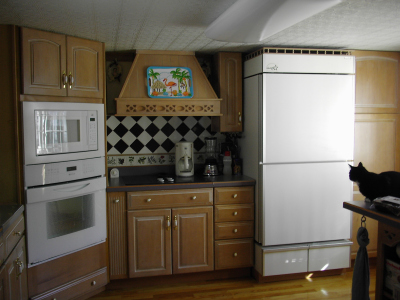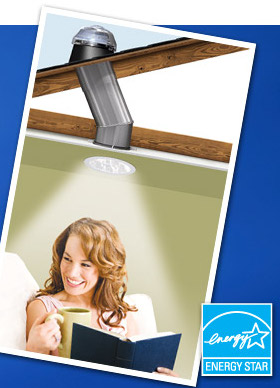
Improving household efficiency
 I
can just hear Roland
now --- "All of this talk about insulating the
home is great, but you shouldn't be using electricity for heat
anyway. What did Zimmy do to lower his non-heat electricity use
before going off the grid?" Well Roland-in-my-head, I'm glad you
asked that, because Zimmy went all out.
I
can just hear Roland
now --- "All of this talk about insulating the
home is great, but you shouldn't be using electricity for heat
anyway. What did Zimmy do to lower his non-heat electricity use
before going off the grid?" Well Roland-in-my-head, I'm glad you
asked that, because Zimmy went all out.
Zimmy installed aluminum
bars on his baseboard heaters as a thermal
heat sink and bought a Geyser heat pump water heater. In the
kitchen, he put in a Sunfrost refrigerator,  an induction cook top, and
a vent to channel excess heat to the water heater (or outside.)
He
switched over to Energy Star appliances, buying a new freezer among
other things. Finally, he installed a dual flush conversion on
the toilet to help save water.
an induction cook top, and
a vent to channel excess heat to the water heater (or outside.)
He
switched over to Energy Star appliances, buying a new freezer among
other things. Finally, he installed a dual flush conversion on
the toilet to help save water.
I wasn't surprised to
see fluorescent and LED lighting on Zimmy's list,
but I did get hung up for a moment on what a solar tube is. These
special skylights use a combination of a domed "daylight capturing
surface" on the outside of the house and a lens on the inside of the
house to maximize the amount of sunlight you receive through a small
skylight. Solar tubes are sure to warm the inventive cockles of
Mark's heart, but at a few hundred dollars apiece, we won't be
installing them anytime soon.
| This post is part of our Energy Efficient Mobile Home lunchtime
series.
Read all of the entries: |
Want more in-depth information? Browse through our books.
Or explore more posts by date or by subject.
About us: Anna Hess and Mark Hamilton spent over a decade living self-sufficiently in the mountains of Virginia before moving north to start over from scratch in the foothills of Ohio. They've experimented with permaculture, no-till gardening, trailersteading, home-based microbusinesses and much more, writing about their adventures in both blogs and books.
Want to be notified when new comments are posted on this page? Click on the RSS button after you add a comment to subscribe to the comment feed, or simply check the box beside "email replies to me" while writing your comment.

Well, I would object to electric heating if the electricity comes from a fossil fuel powerplant, because in that case you lose a lot of energy in conversion. If all your electricity comes from solar power, that doesn't apply.
The heat pump is an excellent idea, BTW. Especially in combination with a borehole so you can make use of geothermal energy. I like geothermal energy because it is always available. No worries about sun or wind... Unfortunately it is still quite expsensive in these parts. It seems to add €30,000 to the cost of a new house in the Netherlands; you have to drill pretty deep here to find warm water.
BTW, 't wasn't me in your head. I was busy cycling from Eindhoven to Vessem and attending a course today. Lovely route through the woods and all. And while it rained most of the day, it was dry for both the outgoing and return leg, so I'm .
.
Zimmy -- Nice house!
I'm glad the real Roland came forward to replace the one in my head.
I'm intrigued to see that you think it's worthwhile to convert solar energy to electricity to heat with if you use a heat pump. Unfortunately, I've read that in our climate (where winters can get more than moderately cold) it's not worthwhile to install an air-source heat pump --- the Energy Savers government website says "Although air-source heat pumps can be used in nearly all parts of the United States, they do not generally perform well over extended periods of sub-freezing temperatures." In our climate, it seems like we'd have to go geothermal to really use a heat pump, which would be fun, but way to pricey for my tastes.
Wood seems to make a lot more sense for us. We have 56 acres of trees that I want to preserve in their natural state, but enough seem to fall or get in the way of the driveway every year that we can just about heat our home on that alone. Plus, relying on any kind of electric heat would have put us in seriously bad shape during our 10 day outage last winter!
Your trailer has a flat root, doesn't it? In that case I don't think you need a light pipe.
A skylight with a properly angled mirror above it should work just as well. You'd get maximum light gain if you could rotate the mirror and change its angle, of course. But a polished curved steel plate would do in a pinch.
Of course the skylight should have double glazing to prevent heat loss as much as possible.
A light pipe is mostly used where you have to go through the attic or extra floors. But I'd guess that for a roof that doesn't have a steep slope (and so a pretty low attic), a skylight with a tunnel beneath it covered with reflective material would probably work well enough, like in the following links: part 1 and part 2
You could also add a removable IR filter. That way you won't be fried in the summer, but you might collect extra warmth in winter.
Of course for the best light capture over the whole day, you'd need a heliostat on the roof.